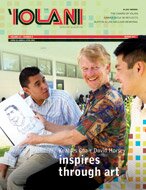This Issue
Spring 2011 - Cover Story
The Cartoon Connection
One of them was Seabiscuit, the crooked legged, underdog of a race horse that won the Triple Crown back in 1938. Father Kenneth A. Bray, founder of the school’s athletic program, told his students all about Seabiscuit to inspire them.
In 2011, another horse has inspired the ‘Iolani community, except this one has two straight legs and has won Pulitzers, not Triple Crowns. He was journalist David Horsey, also an editorial cartoonist and storyteller, who was this year’s Keables Chair Holder and who served a two-week teaching residency at ‘Iolani.
“...the imagination that powers the comment, and the artistic talent that executes it, are keys to a cartoon’s effectiveness.”
A native of Seattle, Horsey is Hearst Newspapers’ two-time Pulitzer Prize-winning editorial cartoonist and columnist who is based at the Seattle Post Intelligencer. His cartoons, columns and multimedia reporting are found at his web site, www.davidhorsey.com.
A reception for faculty, staff and Keables Chair supporters was held on Feb. 3 to honor the legacy of Harold Keables and Keables Chair David Horsey, seated center. Nearly 200 people attended, including Headmaster Dr. Val Iwashita and Member of the Board of Governors Thomas B. Fargo as well as kindergarten teacher Boni Gravelle and Cynthia Iwashita, both seated.
Student Marisa Chow ’12 was one of more than two dozen students who danced a lovely hula at the Keables reception.
“David Horsey was just brilliant,” said art teacher Cheri Keefer. “He asked the fourth graders to describe an ‘Iolani student so he could draw one and the input and feedback was amazing. He created a hawk carrying a surfboard at the beach. He really out the school pride and artist in all of us.”
“A wise editor once told me that, ‘Every stranger has a story to tell,’” Horsey told students.
‘Iolani students know talent when they see ti. Horsey won the Pulitzer Prize for editorial cartooning in 1999 and 2003 and was a finalist for the prize in 1987. In 1998, he received the National Press Foundation’s Berryman Award for Cartoonist of the Year. His multi-faceted career has taken him to national political party conventions, presidential primaries, the Olympics, the Super Bowl and on assignments in Europe, Japan, Mexico and Washington, D.C.
David Horsey and his wife, Nole Ann, met with Upper School science teachers following his Power Point lecture on the public's misperceptions of science.
During three decades at the Seattle Post-Intelligencer, Horsey received 17 first place regional awards from the Society of Professional Journalists for cartooning, governmental reporting and spot news reporting, as well as dozens of other awards from different journalism and community organizations.
At ‘Iolani, he presented lectures for large audiences of students in Seto Hall. In one, he depicted the general public’s erroneous perceptions of science through editorial cartoons on topics such as global warming, the environment and human cloning. In another, he shared his MSNBC.com series Escape to America, which depicted slices of American culture in places off the beaten path.
Fourth graders hold up the ‘Iolani hawk cartoon that David Horsey originated for them.
David Horsey leads an art class for enthusiastic fourth graders. “This is so much fun,” one student exclaimed.
With an intimate and powerful writing style, Horsey proved the editor right with perspectives on an animal shelter in Arizona and a synagogue on Venice Beach.
David Horsey created this editorial cartoon for Hearst Newspapers while serving as Keables Chairholder at ‘Iolani. The Honolulu Star Advertiser also ran the cartoon on February 2.
“Do you think your cartoons are biased,” one student asked.
“Yes!” he answered.
His job is to express his opinion through art, to stir ideas and get people talking. He doesn’t expect everyone to agree with him. In fact, he knows his cartoons may anger some, but we live in a country where we have the freedom to express our opinions.
David Horsey teaches a creative writing non-fiction writing, explaining how newspapers once were lucrative businesses but now the Internet has changed the business model for all media. (Photo: Cathy Lee Chong)
His job is to express his opinion through art, to stir ideas and get people talking.
While teaching a War in the 20th Century class, and showing some of his cartoons depicting war in the Middle East to mostly eleventh and twelfth graders, he encouraged the class to challenge his ideas, to disagree with him if they believe differently. Editorial journalists seek to encourage the exchange of ideas.
Students in Lower School, however, liked the cartoons simply because of the cool art and charicatures. The young ones clamored for his autograph while shouting out his name, “Mr. Horsey! Mr. Horsey!” All of the attention was like fans greeting a rock star. For kindergartners, using only a pen, a blank piece of paper, and the imaginations of 70 kids, he invented an oddly shaped animal with eyes and huge stomach.
David Horsey showed them that the art of charicature is to capture unique qualities about a person’s face. As examples, he drew teachers. Left to right, computer Dalton Sue, David Chun ’80, Dean Yonamine ’83, Horsey, Cheri Keefer and Catherine Fuller ’84.
Dean of Studies Dr. Carey Inouye '66 spoke at the Keables reception about his memories of being a student in a class taught by Harold Keables. The inspiring teacher made the young Inouye want to become a writer.
BBF Wilkerson
His visit may be over, but the impact of his residency has been as indelible as permanent ink. A natural teacher armed with a wealth of stories and experiences, he carried on the teaching legacy of Harold Keables. Horsey demonstrated that cartoons connect people and that a love for learning can be planted with simple seeds like pen, paper and creativity.


